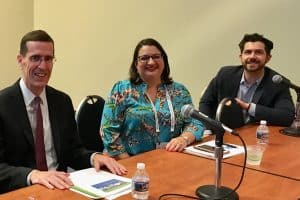
Ian, Michael, Nicole—all names of hurricanes that have affected Florida in recent years.
Librarians Denise Gomez and Marcia Mardis are from Florida State University (FSU) in Tallahassee, and they know a thing or two about natural disasters.
The two researchers presented “Not Another Named Storm: Disaster Planning in Public Libraries” on January 21 at ALA’s 2024 LibLearnX conference in Baltimore. They shared findings from their three-year Institute of Museum and Library Services–funded study exploring public librarians’ disaster roles and identifying the elements that may be essential in an effective disaster plan.
Little-known fact: Many Florida public librarians are statutorily designated first responders, said Mardis, professor of information science, director of the FSU Information Institute, and associate dean for research at FSU’s College of Communication and Information. The statutory obligation is printed on the back of their work badges, she said.
As a result, when disasters hit, librarians there must be available to assist—with water distribution, with forms, and by providing relief blankets and bedding, among other things.
Traditionally in the disaster planning process, the focus is on collections and the building, Mardis said. And while those things are important, “it’s much more about the community.”

In the Florida Panhandle, for example, there is a growing senior population, as well as a growing population of multilingual people with small children and many people with disabilities or mobility issues. Many of them have companion or service animals, and “sheltering tends not to be available for these populations,” she said. “So what happens in that situation?”
While some libraries may go out with mobile units after a disaster, there are still many people whom libraries can’t access. “What about those people that cannot get to us?,” Gomez asked. “They still need services. How can we help them?” Such questions should be part of your library’s disaster planning process, she said.
Another consideration: Your community may begin with one disaster that later becomes a serial disaster, such as when the main employer in town shuts down or when you’re still recovering from a previous storm.
The best time to prepare is beforehand, said Gomez, research assistant at FSU’s Information Institute. “Waiting until that emergency happens might not be the best time to start interacting” with partner agencies, she said. Build those relationships now, and make sure everyone on your team knows what the emergency plan is and how it will be implemented.
The presenters offered suggestions for some issues libraries may want to address when creating and maintaining their own disaster and continuity of operations plans:
- building infrastructure
- technology infrastructure
- community needs
- staff roles and responsibilities
- plan of action
Other suggestions: Triage your collection. Develop a consistent message. Determine who will save the hamster or fish. And certainly review your plan, they said, to determine its strengths, areas for improvement, and what may be missing.
And should disaster hit your community, Mardis said, it will be important for the library to reflect during that “blue-sky time” to avoid perpetuating “problematic planning behavior.”


